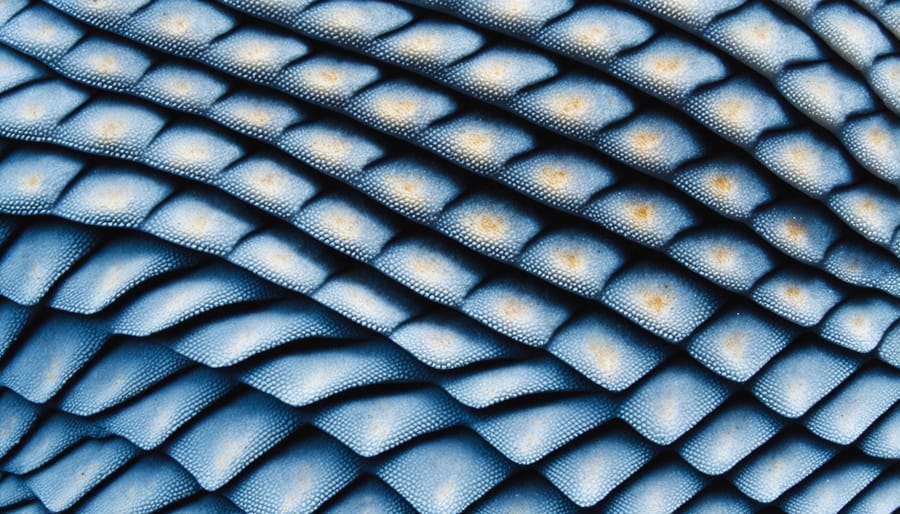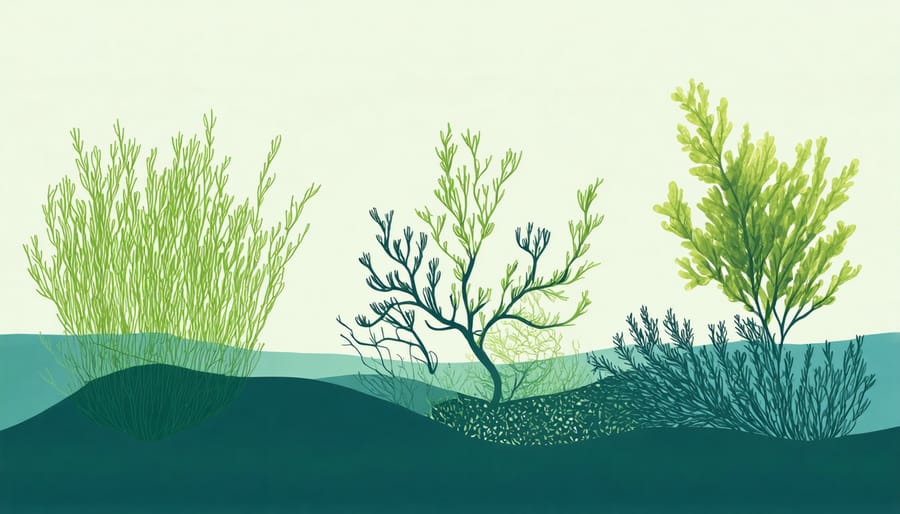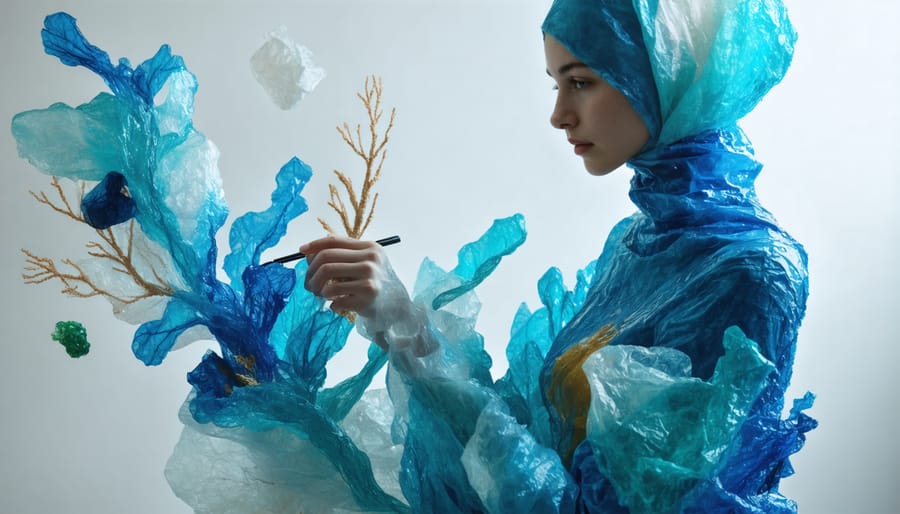
Beneath the waves lies an extraordinary fusion of nature and textile innovation that’s revolutionizing sustainable fashion. Marine organisms, from iridescent jellyfish to protective shark skin, have inspired breakthrough marine science innovations in fabric design and manufacturing. These bio-inspired textiles aren’t just mimicking nature’s aesthetics—they’re pioneering solutions to fashion’s environmental challenges through hydrophobic surfaces, temperature-regulating fibers, and biodegradable materials derived from seaweed and shellfish waste.
As ocean plastics threaten marine ecosystems, a new wave of designers and scientists is turning to the sea not as a victim of fashion’s excess, but as a blueprint for its sustainable future. From bioluminescent-inspired reflective wear to coral-textured sustainable synthetics, marine textile innovation represents a crucial intersection of conservation, technology, and fashion—proving that the most cutting-edge solutions to our industry’s challenges may have been swimming beneath us all along.
This exploration of marine-inspired textiles reveals how nature’s most ingenious adaptations are transforming the fabric of our future, one thread at a time.
Nature’s Underwater Design Laboratory
Shark Skin’s Secrets
Nature’s engineering marvels often inspire groundbreaking innovations, and shark skin stands as a prime example. The microscopic structure of shark skin, known as dermal denticles, features tiny V-shaped ridges that reduce drag and prevent microorganisms from adhering to the surface. This remarkable design has revolutionized marine textile development.
Scientists studying these patterns discovered that shark skin’s unique texture creates small vortices in the water flow, reducing friction by up to 8%. This finding led to the development of ribbed swimsuits and boat hulls that mimic these patterns. The most successful application has been in competitive swimming, where shark-skin-inspired suits have helped break numerous world records.
Beyond speed advantages, shark skin patterns have influenced the creation of antimicrobial fabrics. The same structure that prevents barnacles and algae from growing on sharks has been adapted to create hospital textiles that resist bacterial growth. This bio-inspired innovation demonstrates how studying marine life can lead to sustainable solutions in textile engineering.
Marine biologists continue to uncover new aspects of shark skin properties, promising even more advances in hydrodynamic fabric design. These discoveries not only improve human technology but also highlight the importance of preserving shark species for future innovation.

Mussel-Inspired Adhesives
One of nature’s most remarkable adhesive technologies comes from mussels, which can attach themselves firmly to various surfaces even in turbulent ocean conditions. These marine creatures secrete protein-based adhesives that remain effective underwater, a feature that has captivated scientists and textile innovators alike. The key to their extraordinary sticking power lies in special amino acids, particularly DOPA (3,4-dihydroxyphenylalanine), which forms strong chemical bonds with virtually any surface.
Researchers have successfully developed synthetic versions of these mussel-inspired adhesives, leading to breakthrough applications in marine textiles. These biomimetic materials show promise in creating waterproof fabrics, underwater repair materials, and sustainable alternatives to traditional petroleum-based adhesives. What makes these adhesives particularly valuable is their ability to bond in wet conditions without toxic chemicals, addressing both performance and environmental concerns.
The development of mussel-inspired adhesives represents a perfect example of how studying marine life can lead to sustainable innovations in textile technology. These natural solutions are increasingly being adopted in eco-friendly fashion production, medical textiles, and marine equipment manufacturing.
Sustainable Materials from the Sea
Seaweed Fibers
Seaweed-based textiles represent an innovative breakthrough in sustainable fashion, offering a renewable alternative to traditional fabric materials. These fibers are derived from various species of marine algae, which are processed to extract cellulose and other beneficial compounds. The resulting material exhibits remarkable properties, including natural UV protection, antimicrobial characteristics, and moisture-wicking capabilities.
Companies like AlgiKnit and SeaCell have pioneered methods to transform seaweed into wearable fabrics that are both environmentally friendly and functional. The production process requires significantly less water compared to cotton cultivation and doesn’t compete with food crops for agricultural land. Additionally, seaweed farming helps sequester carbon dioxide and reduces ocean acidification, making it a climate-positive textile solution.
These marine-derived textiles are biodegradable and release beneficial minerals to the skin during wear, including calcium, magnesium, and vitamin E. The fabrics maintain their properties even after multiple washes and can be blended with other sustainable materials to enhance durability and texture.
Fashion designers are increasingly incorporating seaweed textiles into their collections, creating everything from activewear to luxury garments. The material’s natural stretch and breathability make it particularly suitable for sportswear and intimate apparel. As textile technology advances, seaweed fibers continue to demonstrate their potential as a key player in the future of sustainable fashion.

Ocean Plastic Transformation
The transformation of ocean plastic into fashion materials represents a groundbreaking intersection of ocean conservation efforts and sustainable innovation. Companies worldwide are developing sophisticated processes to convert marine debris, particularly plastic waste, into high-quality textile fibers. This process typically begins with collecting plastic waste from beaches and ocean surfaces, followed by thorough cleaning and sorting procedures.
The collected plastic, primarily PET (polyethylene terephthalate), undergoes mechanical recycling where it’s shredded into small flakes. These flakes are then melted and extruded into fine filaments, which can be spun into yarn. Through specialized treatments, the resulting fabric maintains properties crucial for fashion applications, including durability, flexibility, and moisture-wicking capabilities.
Notable innovations include the development of moisture-resistant threads from ocean-bound plastic bottles and the creation of performance fabrics from abandoned fishing nets. These materials are increasingly being adopted by major fashion brands, demonstrating their commercial viability. Some manufacturers have even developed technologies to maintain the traceability of ocean plastic throughout the transformation process, ensuring transparency in the supply chain.
The impact extends beyond environmental benefits, as this initiative creates economic opportunities in coastal communities while addressing marine pollution. Each ton of ocean plastic transformed into textile represents approximately 7,000 plastic bottles removed from marine ecosystems, making fashion a powerful ally in ocean cleanup efforts.
Innovation Meets Conservation

Eco-friendly Production Methods
Marine organisms have inspired groundbreaking sustainable manufacturing processes that minimize environmental impact while maximizing efficiency. Taking cues from filter-feeding creatures like mussels and sponges, innovative textile manufacturers have developed water filtration systems that purify wastewater without harmful chemicals. These systems remove microfibers and dyes naturally, mimicking the way marine animals extract nutrients from seawater.
The byssal threads of mussels have led to the development of water-based adhesives that replace toxic bonding agents in textile production. These bio-inspired adhesives work effectively at room temperature, significantly reducing energy consumption during manufacturing. Similarly, the natural iridescence of fish scales has inspired the creation of pigment-free coloring techniques, eliminating the need for synthetic dyes.
Seaweed-based processing methods have revolutionized fabric finishing, offering a sustainable alternative to traditional chemical treatments. These methods require less water and energy while producing biodegradable waste products that can be safely returned to the environment. Some manufacturers have even adapted the pressure-resistant properties of deep-sea creatures to develop low-energy fabric compression techniques.
This biomimetic approach to textile production not only reduces environmental impact but also creates more durable and efficient materials, proving that nature’s solutions can revolutionize sustainable manufacturing.
Conservation Through Fashion
Fashion has emerged as a powerful medium for promoting marine conservation awareness, with designers and brands increasingly incorporating marine themes and sustainable practices into their collections. These marine-inspired textiles not only showcase the beauty of ocean life but also tell compelling stories about marine ecosystems and their preservation.
Through innovative designs featuring coral patterns, wave motifs, and marine creature representations, fashion creators are helping audiences connect emotionally with ocean conservation causes. Many sustainable fashion brands now collaborate with marine biologists and conservation organizations to ensure their collections accurately represent marine life while raising funds for ocean protection initiatives.
Educational fashion shows and exhibitions featuring marine textiles have become platforms for sharing conservation messages with wider audiences. These events often incorporate multimedia presentations about marine ecosystems alongside the fashion displays, creating immersive experiences that inspire action.
Additionally, some brands have pioneered the use of recycled ocean plastics in their marine-themed collections, demonstrating how fashion can directly contribute to ocean cleanup efforts while raising awareness about plastic pollution. These initiatives have proven particularly effective in engaging younger generations in marine conservation efforts, showing how style and sustainability can work together for positive environmental impact.
The future of marine textiles stands at an exciting crossroads of innovation, sustainability, and conservation. As our understanding of marine ecosystems deepens, designers and researchers are developing increasingly sophisticated bio-inspired materials that not only mimic the remarkable properties of marine life but also contribute to ocean preservation. These advances in marine textile technology are reshaping the fashion industry’s approach to sustainability, offering alternatives to harmful synthetic materials and traditional production methods.
The integration of marine-inspired textiles with marine preservation initiatives is creating a powerful synergy between fashion and conservation. From biodegradable fibers that mimic shark skin to algae-based fabrics that actively absorb CO2, these innovations are proving that sustainable fashion can be both functional and environmentally responsible.
Looking ahead, marine textiles are poised to play a crucial role in addressing ocean pollution and climate change. The industry’s commitment to developing ocean-friendly materials, combined with growing consumer awareness, suggests a future where fashion actively contributes to marine ecosystem health. As more brands embrace these sustainable alternatives, we can expect to see a transformation in how we produce and consume textiles, ultimately leading to a more harmonious relationship between fashion and our oceans.
This evolution in textile innovation represents more than just a trend; it’s a fundamental shift towards conscious design that respects and protects our marine environments for future generations.
jessica
Ava Singh is an environmental writer and marine sustainability advocate with a deep commitment to protecting the world's oceans and coastal communities. With a background in environmental policy and a passion for storytelling, Ava brings complex topics to life through clear, engaging content that educates and empowers readers. At the Marine Biodiversity & Sustainability Learning Center, Ava focuses on sharing impactful stories about community engagement, policy innovations, and conservation strategies. Her writing bridges the gap between science and the public, encouraging people to take part in preserving marine biodiversity. When she’s not writing, Ava collaborates with local initiatives to promote eco-conscious living and sustainable development, ensuring her work makes a difference both on the page and in the real world.
